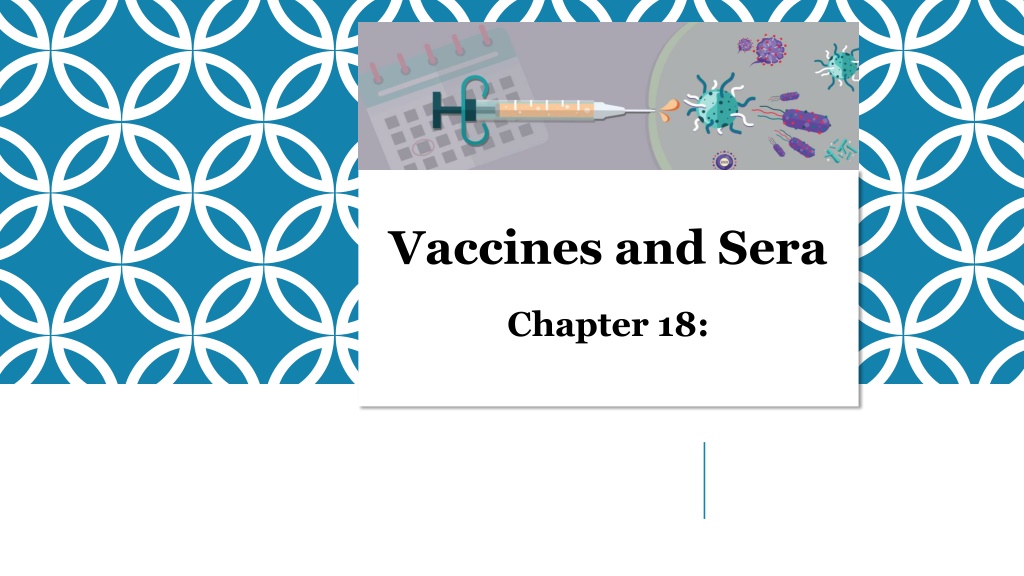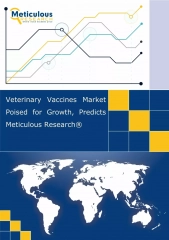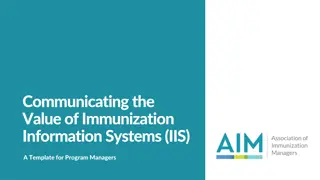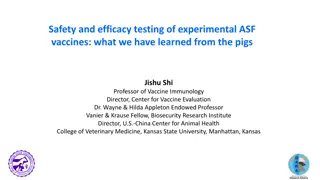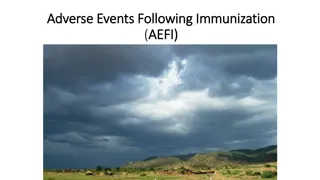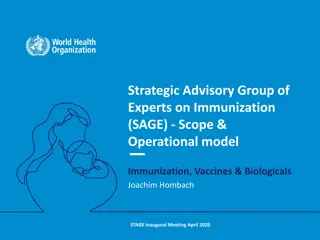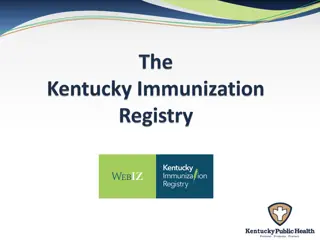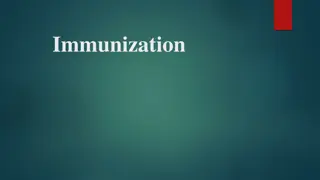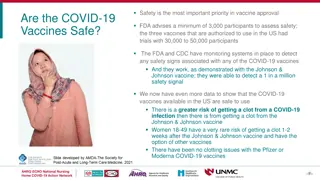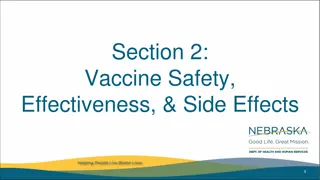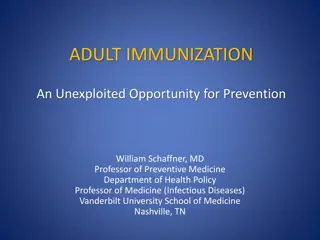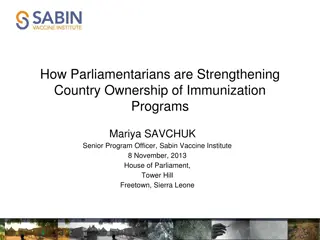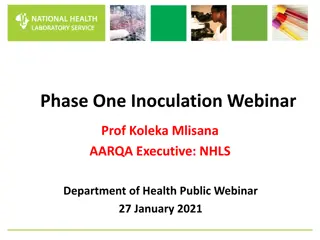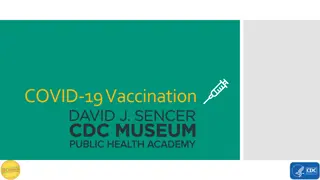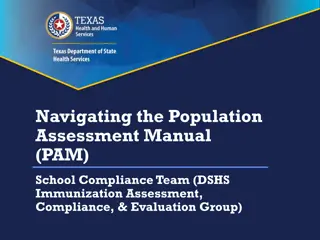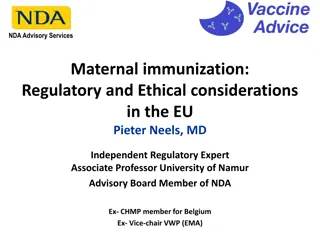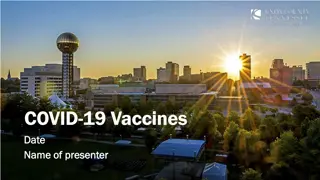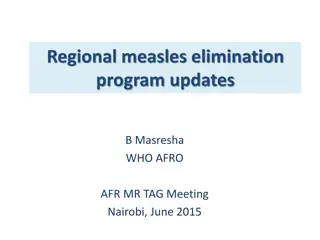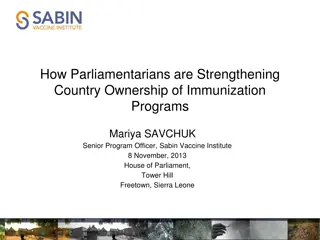Vaccines and Immunization
Explore the world of vaccines and immunization, learning about active and passive immunity, childhood and adult immunization schedules, common vaccines, contraindications, adverse effects, and the importance of immunization in preventing diseases. Discover the process of immunization and how it stimulates active immunity to protect individuals from various pathogens.
Download Presentation

Please find below an Image/Link to download the presentation.
The content on the website is provided AS IS for your information and personal use only. It may not be sold, licensed, or shared on other websites without obtaining consent from the author.If you encounter any issues during the download, it is possible that the publisher has removed the file from their server.
You are allowed to download the files provided on this website for personal or commercial use, subject to the condition that they are used lawfully. All files are the property of their respective owners.
The content on the website is provided AS IS for your information and personal use only. It may not be sold, licensed, or shared on other websites without obtaining consent from the author.
E N D
Presentation Transcript
Vaccines and Sera Chapter 18:
Stimulate Stimulate the production of antibodies BIOLOGICALS: ACTIONS Provide preformed antibodies to facilitate an immune reaction Provide React specifically with the toxins produced by an invading pathogen React
Active Immunity The body recognizes a foreign protein and begins producing antibodies to react with it Passive Immunity Occurs when preformed antibodies are injected into the system and react with a specific antigen TYPES OF IMMUNITY
IMMUNIZATION Definition The process of artificially stimulating active immunity Goal To cause an immune response without having the client suffer the full course of a disease https://youtu.be/zacqRZH5t5s
Diphtheria, pertussis, tetanus Haemophilus B Hepatitis B, Hepatitis A Chickenpox Polio Measles, mumps, and rubella CHILDHOOD VACCINATIONS
VACCINES Action Stimulate active immunity in people who are at risk Indication Depends on the exposure the person will have to pathogens
Contraindication Acute febrile illness Immunosuppressive drug therapy Immunodeficiency states Hematological cancers Pregnancy VACCINES
Fever Anorexia Rash Vomiting Malaise Irritability Chills Pain, Redness, and Swelling at the Injection Site Fretfulness Drowsiness VACCINES: ADVERSE EFFECTS
Assess and Monitor Effectiveness Client Teaching NURSING CONSIDERATIONS Maintain immunization records Most vaccines can cause fever and soreness at the site of injection Women of childbearing age who receive a MMR or varicella immunization must avoid becoming pregnant for 3 months
Hepatitis B Influenza MMR Tdap Varicella PROTOTYPE https://www.cdc.gov/vaccines/hcp/vis/current-vis.html
IMMUNE SERA Sera that contain antibodies to specific bacteria or viruses Types Antitoxin Antivenom
IMMUNE SERA AND ANTITOXINS Action Passive immunity Indication Prophylaxis against specific disease after exposure Lessen the severity of a disease
IMMUNE SERA AND ANTITOXINS Contraindications History of severe reaction to any immune sera Used with caution Pregnancy Coagulation defects Previous exposure to the immune sera
Adverse effects Rash Nausea Vomiting Chills Fever Allergic Reaction Chest tightness, decreased blood pressure, and difficulty breathing IMMUNE SERA AND ANTITOXINS
NURSING Assess and Monitor Effectiveness CONSIDERATIONS
QUESTION 1 What is the best source for current recommendations concerning vaccination guidelines? A. the Centers for Disease Control and Prevention B. the American Medical Association C. the American Nurses Association D. National Poison Control Center
QUESTION 2 The elderly client returns from a health care visit and asks the nurse why another flu shot was necessary this year because the client got one last year. The nurse's best response is: A. Once a client turns 75, he needs vaccine boosters every 2 years. B. The vaccine is good for 5 years, so he did not need another one yet. C. The vaccine is given every 6 months to prevent the flu. D. Each year a new vaccine is developed based on the strains most prevalent.
QUESTION 3 A mother brings her 18-month-old son into the clinic for his diphtheria, tetanus, and pertussis vaccine. The child has a runny nose and a fever of 102.4 F and is coughing. What should the nurse do? A. Administer the vaccine. B. Instruct the mother to give the child 2 doses of Tylenol and bring him back to the clinic in the afternoon. C. Administer a decreased dose of the vaccine. D. Instruct the mother to bring the child back to the clinic for the immunization when he is free of allergic or cold-like symptoms.
